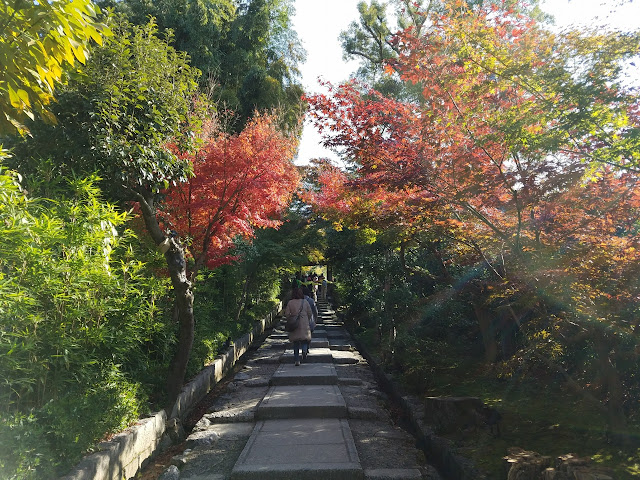Previously on Sekai Ichi, I took a walk through the Higashiyama district in Kyoto. An ideal stop along this stroll is Kodai Temple (高台寺, Kōdai-ji, lit. 'tall pedestal temple'), a Zen Buddhist temple. The temple was built in honour of Toyotomi Hideyoshi (豊臣 秀吉 1537-1598), a general who united and ruled Japan at the end of the 16th-century's Warring States period.
The entrance to Kodai-ji is so low-key, you might miss it completely, as indeed I did. Basically, you're looking for a shallow stone stairway, like this. This path is called the Nene-no-Michi (ねねの道, lit. 'road of Nene'), and is named after Nene (ねね, 1546-1624), the widow of Toyotomi Hideyoshi. Nene established Kodai-ji in 1606, in memorial of her late husband. After her death, her spirit was enshrined at this temple as well.
Chibified versions of Hideyoshi and Nene also serve as the temple's mascots, such as on this multilingual signboard. If you're still trying to find the entrance, just look for these two.
At the top of those stairs, I came across this hall, known as Kodai-ji Tenman-gu (高台寺天満宮). My Google-fu, and the suffix "gu", tells me this is a Shinto shrine. However, it was decorated in the colours of the Buddhist flag, and was surrounded by sutra wheels you can turn with your hands to "read", indicating that it may be a Buddhist installation after all.
The main hall was most recently rebuilt in 1912, after having been destroyed by fire on multiple occasions. The building also doubles as a small museum, free with admission, which holds a few artifacts and miscellanea related to Toyotomi Hideyoshi.
Kodai-ji is a Zen Buddhist temple, a member of the Rinzai school (臨済宗, Rinzai-shū) to be exact, so naturally it has a rock garden. The field of gravel is meant to represent a vast ocean, and is shaped into different patterns by its caretakers.
The gardens are built around a pair of ponds. In between them stands a sub-hall, the Kaizan-do (開山堂, lit. 'open mountain hall'), linked on either side by covered bridges. Nene used to pray for her late husband in this hall.
This stairway wound up through -- you guessed it -- another bamboo grove. Climbing up this way leads you to the mausoleum of Toyotomi Hideyoshi and Nene, and further up, to a pair of tea houses.
There is another way up that hill by way of this covered bridge across the pond, but it was closed to visitors at the time.
I came across this stone dragon head near the foot of the bamboo path. I wonder what it could have been used for...?
Oh yeah, and Kodai-ji had the best fall colours I saw in Kyoto. Here are some examples:
This tree, along the Nene-no-Michi entrance, had a splotch of red among the green, like the cherry syrup poured on top of a cup of shaved ice.
The ponds may have been murky, but the surrounding trees made up for it with their own colours.
These trees practically looked like they were on fire!
So did this one. Actually, looking from afar, the way the lights and shadows played on these leaves, it reminds me of painting or airbrushing techniques. Speaking of art, join me as I rest a spell at the Kyoto International Manga Museum, next time on Sekai Ichi!
Hours: Open from 9:00 AM to 5:30 PM. Admission ends 30 minutes before closing time. No regular closing days.
The temple grounds are open late, to 9:30 PM, for evening illuminations during the spring (late March to early May), summer (1 to 18 August), and autumn (late October to early December) seasons.
Costs: ¥600.
Address: 526-39 Shimogawara-chō, Higashiyama-ku, Kyōto-shi, Kyōto-fu 〒605-0825
Access: From Kyoto Station, take bus #100 (stand D1), #110 (D1), or #206 (D2) and get off at the Higashiyama-Yasui stop (15 minutes, ¥230). The temple entrance is 5 minutes on foot from the bus stop.
Kodai-ji can also be reached on foot in 15 minutes from Gion-Shijo Station, on the Keihan Main line (KH) (use exit 6), or in 20 minutes from Kawaramachi Station, on the Hankyu Kyoto line (HK) (use exit 1B).














